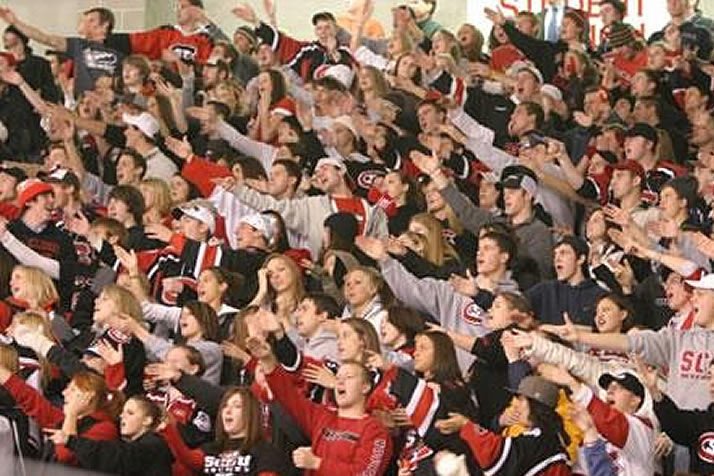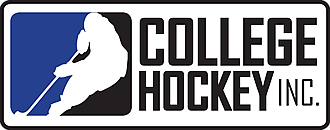Monday, October 4, 2010
College Hockey Opens with plenty of Questions

As the puck drops on the 2010-11 season, there are many questions that will be answered by the time a new champion is crowned at the Xcel Energy Center in St. Paul in April. Among those that bear the closest watching:
Can Boston College repeat as the National Champion?
Which players will step up to the “Next Level”?
What will be the fate of the college players that left early for the pros or for Canadian Junior?
What impact will Paul Kelly’s College Hockey, Inc. have on the future of college hockey?
Let’s try to look into the crystal ball and provide a few answers to the questions that every hockey fan will be watching.
Can Boston College repeat as National Champions?
The 2010 Champion Boston College Eagles return to with a very strong group of upper classmen joined by an equally impressive group of incoming freshmen.
After a somewhat shaky start last year, BC found their stride and blew through the second half of the campaign capturing the Beanpot and Hockey East Championship en route to a dominating performance at the Frozen Four in Detroit. In 2010, BC is led by a trio of players that while small in stature (all are under 5′ 8″) pack plenty of offensive punch. Senior captain Joe Whitney (17, 28, 45) is joined by senior Brian Gibbons (16, 34, 50) and junior Cam Atkinson (30, 23, 53) on BC’s top line. New York Rangers’ 1st rounder and World Junior star Chris Kreider and 2nd round draft choice Jimmy Hayes (Chicago) are poised for breakout years also. On defense, BC is led by senior goaltender John Muse who has backboned the Eagles to two national championships in his three seasons and a trio of six-foot plus 2nd round NHL draft picks, junior Tommy Cross (Boston) and sophomores Brian Dumoulin (Carolina) and Philip Samuelsson (Pittsburgh).
While BC looks to be a strong favorite to defend the title, North Dakota, Michigan and Yale lead a host of teams that will try to wrest the title off of Chestnut Hill. North Dakota led by preseason WCHA Player of the Year Chay Genoway, 2010 WCHA Rookie of the Year Danny Kristo and NHL 1st rounders Derek Forbot and Brock Nelson will be the heavy favorites to win the perennially strong WCHA. Michigan, after losing only two seniors and with a strong incoming class will look to rebound from an up and down 2010 season and Yale, led by 2011 US World Junior Head Coach Keith Allain and forwards Broc Little, Brian O’Neill, and Denny Kearney should all challenge for the 2011 title.
Which Players will ascend to the “next” Level?
Although college hockey lost a number of top players to the professional ranks, there is no shortage of returning stars that are poised to take the next step. Notre Dame Sophomore and Detroit 1st rounder Riley Sheahan will be looking to improve on a very strong first season in South Bend. Chris Kreider, a New York Rangers 1st rounder and the only non-NHLer to be named to last year’s US World Championship team leads a tremendous group of NHL prospects in Brian Dumoulin, Tommy Cross and Philip Samuelsson at BC. Merrimack scoring machine Stephane DaCosta and last year’s Hockey East Player of the Year and Hobey Baker finalist Gustav Nyquist of Maine all figure to be break out stars in 2010?11.
In addition, college hockey will boast a number of potential superstars who were featured at last year’s NHL Draft. First rounders Jaden Schwartz (Colorado College), Derek Forbot (North Dakota), Nick Bjugstad (Minnesota), Beau Bennett (Denver), Kevin Hayes (BC), Charlie Coyle (BU) and Brock Nelson (North Dakota) will all be closely watched by college fans and NHL scouts all year.
What will be the fate of the college players that left early for the pros or for Canadian Junior?
While college hockey continues to see many players leave before graduation, college hockey continues to make its mark in the NHL. While nothing is final, the early results continue to be promising. Already, 2010 college stars Nick Leddy (Minnesota, Chicago), Bobby Butler (UNH, Ottawa), Zac Dalpe (Ohio State, Carolina), Matt Bartkowski (Ohio State, Boston), Derek Stepan (Wisconsin, New York Rangers), Casey Wellman (Merrimack, Minnesota), Patrick Wierioch (Denver, Ottawa) have made huge impressions in NHL training camps with several poised to have move directly from campus into the NHL. Other players like RPIers Jerry D’Amigo (Toronto) and Brandon Pirri (Chicago), Blake Geoffrion (Wisconsin, Columbus), James Marcou (UMass, San Jose), Kyle Palmieri (Notre Dame, Anaheim), Chris Summers (Michigan, Florida), Steve Kamfer (Michigan, Boston) and Jordan Schroeder (Minnesota, Vancouver) seem to have used college hockey as a springboard to promising NHL careers.
On another level, 2010 collegian’s Louis LeBlanc (Harvard) and Tyler Pitlick (Minnesota State) seem to have left campus only to be relegated to the Canadian junior ranks and hockey fans will have to wait to see if their decision to leave college was a wise one.
Hockey fans can debate the pros and cons of the current NHL’s Collective Bargaining Agreement on college hockey but it is clear that those players drafted out of college or out of the feeder leagues to the NCAA (e.g. USHL or NTDP) hold a much stronger bargaining chip than their Canadian junior counterparts. Under the current CBA, unless a Junior player makes the NHL roster he is required to play the entire season for his former Junior team (e.g. 4th overall pick Ryan Johansen and 12th overall Brandon Gormley) and any NHL contract that he has signed is tolled (delayed). Conversely, those players drafted out of the NCAA that choose to leave early can play in either the AHL (e.g. RPI’s Jerry D’Amigo) or in the NHL where they can make a salary and more importantly, start to use a year on any entry level contract. From both a hockey and a financial perspective both sides favor the NCAA route.
What impact will Paul Kelly and College Hockey, Inc. have on the future of college hockey?
After only nine months in existence, College Hockey, Inc. has enjoyed an auspicious debut. Under the leadership of former NHL Players’ Association Executive Director Paul Kelly and charged with representing and furthering the interests of the 58 DI hockey programs, CHI seems to have started to make progress in areas ranging from equipment changes (the potential move from full masks to half shields), NCAA regulations, NHL/NCAA bargaining discussions, adding new programs (Penn State), television and media coverage, sponsorship and recruiting. Kelly’s group, the brainchild of the Hockey Commissioners’ Association and the DI coaches has started to take the fight to the Canadian junior programs and to grow college hockey’s presence.
To date, CHI has been responsible for leading the discussion to move from full shields to half shields at the DI level. Long overdue in this writer’s mind, the half shield would cut down on the number of head shots and high sticks that that plague college hockey. It would also allow college hockey to fall in line with every top amateur hockey league in the world. Another CHI milestone includes the addition of Penn State to the ranks of DI hockey which could signal the formation of a Big Ten hockey conference and the addition of other new programs.
On the marketing and promotional front, CHI has already attracted new sponsors to college hockey and started to lay the groundwork for a centralized college hockey website, a sorely needed real time college hockey scoreboard and highlights page, increased television coverage both in the US and Canada and other unique marketing opportunities like a college hockey video game.
Probably the biggest impact CHI has had in the past year is in the recruiting and education of potential hockey players. CHI standing in the stead of the individual college hockey programs has crisscrossed North America meeting with players and their families to extol the benefits of the college hockey route over that of the Canadian junior leagues. Most recently, CHI attracted the top young players in Ontario to an invitation-only player showcase. In attendance were the coaches from over twenty DI programs as well as NHL Central Scouting and a number of ex-college/NHL players. It is no doubt, that continued programs like these will start to have a positive effect on the decisions of young players to choose NCAA hockey as a path to the NHL.
Overall, there is no doubt that the 2010 -11 season will hold the answers to these many questions and speaking as a fan “I can’t wait!”
